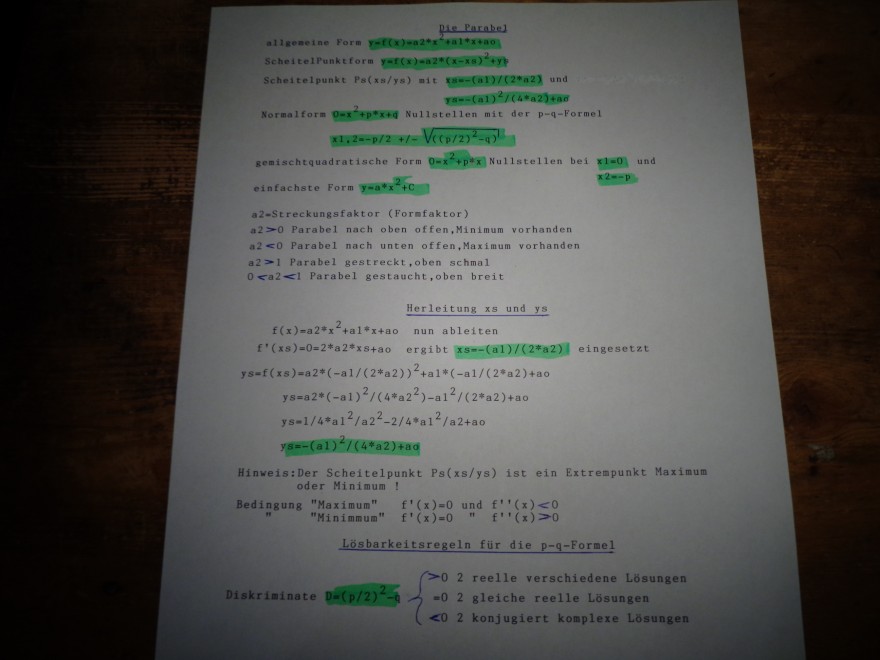a)
f(x)=1*x²-6*x zuerst die 1 ausklammern
..=1*(x²-6*x) binomische Formel (x-b)²=x²-2*b*x+b²
2*b=6 → b=6/2=3 → b²=3²=9
..=1*(x²-6*x+3²-3²) nun die -3² ausklammern
..=1*x²-6*x+3²*1-3²*1 nun wieder die 1 ausklammern
..=1*(x²-6+3²)-3²*1 → binomische Formel
2*b=6 → b=3
y=f(x)=1*(x-3)²-9
y=f(x)=1*(x-3)²-9
Hinweis:Die quadratische Ergänzung ist +3²-3²=0,dadurch wird die Gleichung nur umgeformt und nicht verändert.
b)
f(x)=1*(x²-1*x) binomische Formel (x-b)²=x²-2*x+b²
2*b=1 → b=1/2=0,5 → b²=(1/2)²=1/4=0,25
y=f(x)=1*(x-0,5)²-0,25
c)
f(x)=1*(x²+3/2*x) → binomische Formel (x+b)²=x²+2*b*x+b²
2*b=3/2 → b=3/2*2)=3/4 → b²=(3/4)²=9/16
y=f(x)=1*(x+0,75)²-9/16
Infos,vergrößern und/oder herunterladen

Text erkannt:
Die Parabe] af 1geneine Form \( y=f(x)=a 2 * x^{2}+a 1+x+a 0 \) Scheitelpunkt form \( \left.y=f(x)=a 2^{*}(x-x 8)^{2}+y\right\} \) Scheite1punkt \( \mathrm{Ps}(\mathrm{xs} / \mathrm{ys}) \mathrm{mit} \mathrm{xse-}(\mathrm{a} 1) /(2 * \mathrm{a} 2) \) und
\( \mathrm{y} \mathrm{se-}(\mathrm{a} 1)^{2} /(4 * \mathrm{a} 2)+\mathrm{ad} \)
Normalform \( 0=x^{2}+p^{*} x+d \) Nullstellen mit der p-q-Formel \( x 1,2=-p / 2+/-\sqrt{\left((p / 2)^{2}-q\right)} \)
gemischtquadratische Form \( \left.0=x^{2}+p^{*} x\right] \) Nu11stellen bei \( x 1=0 \) und
einfachste Form \( y=a^{*} x^{2}+c \)
a 2-Streckungsfaktor (Formfaktor) \( a 2>0 \) Parabel nach oben offen, Minimum vorhanden a \( 2<0 \) Parabel nach unten offen,Maximum vorhanden \( a 2>1 \) Parabel gestreckt,oben schmal 0 <a \( 2<1 \) Parabel gestaucht,oben breit
\( \underline{\text { Herleitung } x s} \) und ys \( f(x)=a 2^{*} x^{2}+a 1^{*} x+a \circ \) nun ableiten
\( f^{\prime}(x s)=0=2 * a 2 * x s+a 0 \quad \) ergibt \( \left.x s=-(a 1) /(2 * a 2)\right] \) eingesetzt
\( y s=f(x s)=a 2 *(-a 1 /(2 * a 2))^{2}+a 1 *(-a 1 /(2 * a 2)+a 0 \)
\( y s=a 2 *(-a 1)^{2} /\left(4^{*} a 2^{2}\right)-a 1^{2} /(2 * a 2)+a 0 \)
\( \mathrm{ys}=1 / 4 * \mathrm{a} 1^{2} / \mathrm{a} 2^{2}-2 / 4 * \mathrm{a} 1^{2} / \mathrm{a} 2+\mathrm{ao} \)
\( y s=-(a 1)^{2} /(4 * a 2)+a d \)
Hinweis:Der Scheitelpunkt Ps(xs/ys) ist ein Extrempunkt Maximum oder Minimum
Lösbarkeitsregeln für die p-q-Formel
Diskriminate D=(p/2) \( ^{2}-\mathrm{p}\left\{\left\{\begin{array}{l}>02 \text { reelle verschiedene Lösungen } \\ =02 \text { gleiche reelle Losungen } \\ <02 \text { konjugiert komplexe Losungen }\end{array}\right.\right. \)